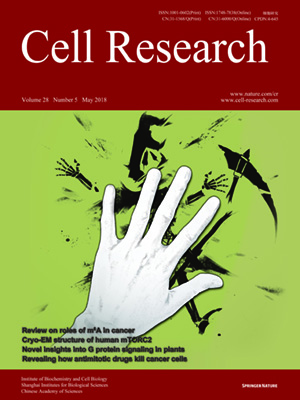
Volume 28, No 5, May 2018
ISSN: 1001-0602
EISSN: 1748-7838 2018
impact factor 17.848*
(Clarivate Analytics, 2019)
Volume 28 Issue 5, May 2018: 544-555 | Open Access
ORIGINAL ARTICLES
Anti-mitotic chemotherapeutics promote apoptosis through TL1A-activated death receptor 3 in cancer cells
Chen Qi 1, Xin Wang 1, Zhirong Shen 2, She Chen 3, Hong Yu 4, Noelle Williams 4 and Gelin Wang 1
1 School of Pharmaceutical Sciences, Tsinghua University, Beijing 100084, China; 2 BeiGene, Beijing 102206, China; 3National Institute of Biological Sciences, Beijing 102206, China and 4 Department of Biochemistry, University of Texas Southwestern Medical Center, Dallas, TX 75390-9152, USA
Correspondence: Gelin Wang (gelinwang@tsinghua.edu.cn)
The commonly used antimitotic chemotherapeutic agents such as taxol and vinblastine arrest cell cycle progression by disrupting mitotic spindles, and cause cancer cells to undergo apoptosis through ‘mitotic catastrophe’. The molecular mechanisms by which these drugs induce apoptosis and their relevance to clinical efficacy are not known. Facilitated by a new spindle poison diazonamide, we found that apoptosis induced by these agents requires death receptor 3 (DR3). Mitotic arrest by these agents induces lysosome-dependent secretion of the DR3 ligand, TL1A. Engagement of TL1A with DR3 stimulates the formation of FADD-containing and caspase-8-containing death-inducing signaling complex (DISC), which subsequently activates apoptosis in cells that express DR3. Expression of DR3 and TL1A correlates with the apoptotic response of human tumor xenograft models and human cancer cell lines to antimitotic drugs, providing further evidence that these drugs kill cancer cells through the DR3/TL1A-mediated pathway. These results suggest that TL1A and DR3 may hold promise to be used as biomarkers for predicting clinical response to antimitotic therapeutics.
10.1038/s41422-018-0018-6
FULL TEXT | PDF
Browse 2053


